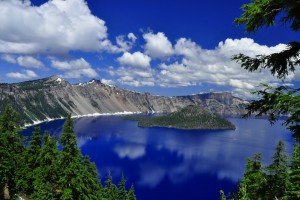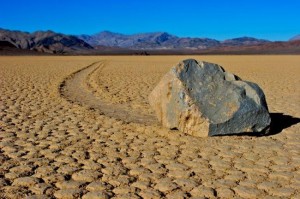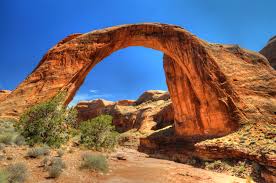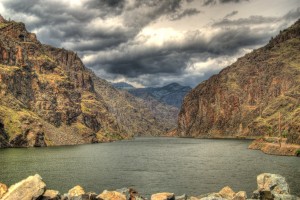I recently came across an article discussing some of the record-setting natural wonders in the United States. A lot of times, people tend to forget how large and diverse the United States truly is. Whether it’s desert, tundra, forest, tropical islands or rolling hills, it seems like the United States has something for everybody.

Gold miners first discovered Crater Lake in 1853, naming it “Deep Blue Lake”. Because it was in an isolated area, however, its discovery was forgotten for a long time.
In south-central Oregon, smack in the middle of the Cascade Mountain range, lies Crater Lake. Created by the eruption and collapse of a volcano some 7,000+ years earlier, it is the deepest lake in the US, at 1,943 feet at its deepest. In the winter, you can take a look at it while going on a snowshoeing trek, but it’s just as beautiful in the summer, when more of Crater Lake National Park is accessible. Bicyclists love the 33-mile loop around the rim of the lake, but it features some very steep climbs, so it’s not recommended for beginners.
South of Crater Lake, in Sequoia National Park, California, stands the largest living tree in the world, “General Sherman”. It’s a staggering 275 feet high, and about 103 feet around at its base. There are many larger (and wider) trees out there, but sadly none of them are still living.

The mysterious “sliding stones” in Death Valley have baffled people since settlers first encountered them some 160 years earlier.
Death Valley, also in California, is the hottest and lowest place in the United States. Because of its extreme climate, this grimly-named region has some of the most adaptable plant and animal life in the world. Formed when movement in the earth’s crust caused the land to sink, it’s over 282 feet below sea level. The top of the highest mountain in the park, Telescope Peak, is a 2-mile drop from the Badwater Basin floor, which is twice the depth of the Grand Canyon.
On Hawaii Island stands the dormant volcano Mauna kea. When measured from its base on the ocean floor, it measures about 33,000 feet in height, taller than Mount Everest. To the ancient Hawaiians, the summit of the volcano was a spiritual place that only royalty and tribal chiefs were allowed to visit. Every year, thousands of people take the long trip up to the top of the mountain to visit the observatories perched up there. Every night out of the year, the Visitor Information Station at the Onizuka Center for International Astronomy holds a free public stargazing program on the summit.
Up north in Alaska lies Denali National Park and Reserve, a massive park roughly half the size of Rhode Island. It’s home to Mt. McKinley, which, at 20,320 feet high, is the highest mountain in North America. If you camp in the area any time between August and May, you might get a chance to see the fabled Aurora Borealis, or Northern Lights.
More than 200 million years ago, heavy rains and a rising river swept through what is now Utah, cutting wide swaths through the water-soluble sandstone and creating various unique shapes in the landscape. One of the most impressive of these is the Rainbow Bridge National Monument. At 290 feet tall, it is the tallest natural bridge in the United States.
For 90 percent of the year, the sun is shining in Yuma, Arizona, the sunniest place in the world and the least humid city in the US. On average, it rains only 16 days out of the year in the city, the lowest number in the nation. Nearby, you can go hiking in the Laguna Mountains, or check out the ghost town Castle Dome Landing.
Further east in Minnesota, in a little corner of the state called the Northwest Angle Inlet, is the northernmost point in the continguous United States. The northern-most point in all of the US, however, is at Point Barrow, Alaska. The only way to get to “The Angle”, as the locals call it, is to drive through Canada or take a boat through Manitoba Bay. It’s apparently a great place for fishermen, with plenty of walleye and bass. You can rent lakefront cabins, go ice fishing and even enjoy a nine-hole golf course.
While the Grand Canyon might be the most famous canyon in North America, the deepest one is actually Hell’s Canyon, in eastern Oregon, eastern Washington and western Idaho. The canyon is more than 8,000 feet deep, more than 2,000 feet deeper than the Grand Canyon. At the bottom of the canyon is Rush Creek Rapids, which you can view from Hat Point lookout, the highest point of the canyon in Oregon.
Over 2,500 miles long, the Missouri River is the longest in the United States. It begins in the Rocky Mountains of Montana, winding south and east before joining the Mississippi River near the city of St. Louis. The river originates in Three Forks, Montana, a small, rustic town nestled in the mountains.

